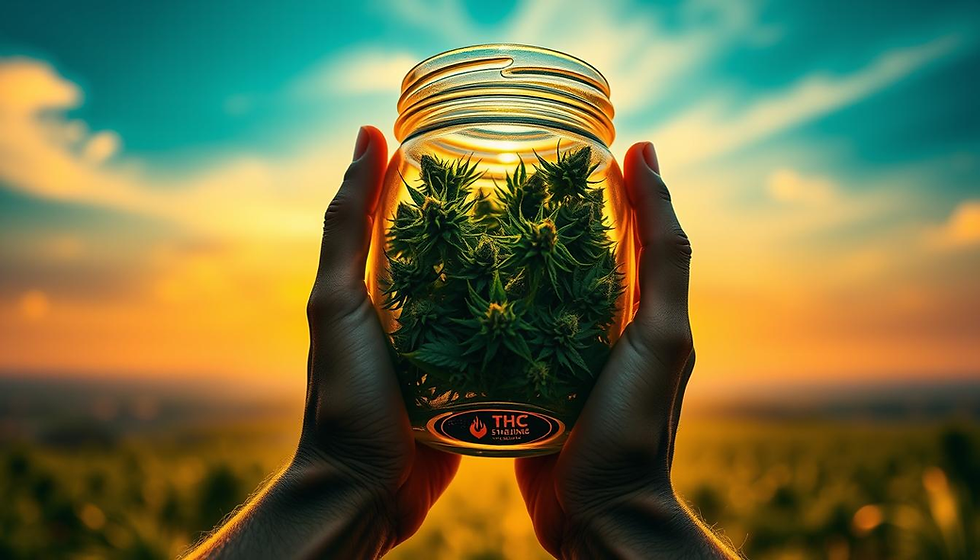Hemp Bioplastic: Future of Packaging
- THC INDIA STORE

- Feb 23, 2023
- 2 min read
Updated: Sep 10, 2023
Hemp Bioplastic: Future of Packaging
Hemp bioplastic, derived from the fibers of the hemp plant, a variety of Cannabis sativa, is an eco-friendly alternative to traditional plastics. It falls under the category of bioplastics, crafted from renewable plant sources rather than fossil fuels. Bioplastics are hailed for their biodegradability, breaking down naturally without harmful residue, and their reliance on renewable resources, reducing carbon emissions.

Features of Hemp Bioplastic
Sustainability: Hemp is a renewable resource, needing no pesticides or herbicides, thus safeguarding soil health. It consumes less water and energy compared to other crops.
Durability and Strength: Hemp bioplastic excels in durability, resisting breakage, cracks, and shattering. It stands up to UV rays and extreme temperatures, ensuring long-lasting quality.
Versatility: Moldable in various shapes and sizes, it suits diverse applications such as packaging, automotive parts, and construction materials. It's also both biodegradable and recyclable, enhancing its eco-friendliness.

Hemp Plastic vs. Traditional Plastics
Environmental Impact: Hemp bioplastic boasts a lower carbon footprint than traditional plastics. Studies show significantly reduced greenhouse gas emissions during production compared to polyethylene and polypropylene.
Physical Properties: Hemp bioplastic outperforms traditional plastics in terms of strength and durability. It exhibits higher tensile and impact strength, making it ideal for long-term use in various products.

How to Make Hemp Bioplastic
The production of hemp plastic involves several steps:
Harvesting Hemp: Hemp plants are harvested using specialized equipment.
Drying and Decortication: Hemp plants are dried and then subjected to decortication, separating fibers from plant material.
Extraction: Cellulose is extracted from hemp fibers, either chemically or mechanically.
Spinning: The extracted cellulose is spun into yarn or fiber forms.
Polymerization: Hemp fibers are chemically bonded to create a plastic-like material, using additives and heat.

Applications of Hemp Bioplastic
Hemp bioplastic's versatility makes it suitable for a wide range of applications, including:
Automotive parts
Packaging materials
Consumer products
Construction materials
Furniture
Industrial products
Medical devices
Agriculture products
Sports equipment
Personal care products
Electronics

Barriers to Wider Adoption of Hemp Bioplastic
While hemp bioplastic holds promise, barriers to its wider adoption include:
Cost: Currently more expensive to produce than traditional plastics due to newness and raw material costs.
Limited Availability: Not as widely available as traditional plastics, primarily due to production infrastructure development.
Lack of Infrastructure: Specialized equipment and infrastructure are needed for production, posing challenges for scaling up.
Legal Restrictions: In some regions, hemp cultivation is restricted due to its association with marijuana, limiting raw material availability.
Limited Public Awareness: Many consumers and companies are unaware of hemp bioplastic's benefits, hindering market adoption.
Conclusion and Future Outlook
Hemp bioplastic, with its sustainability, durability, and versatility, is poised for growth. As production efficiency and infrastructure improve, barriers like cost and availability are expected to diminish. As more people become aware of its advantages, the hemp bioplastic industry is likely to witness significant expansion. A market research report forecasts the global bioplastics market to reach $41.3 billion by 2026, with a compound annual growth rate of 19.5%. Embracing hemp bioplastic can lead to a more sustainable and eco-conscious future. Hope we were able to give you an overview of Hemp Bioplastic: Future of Packaging




Comments